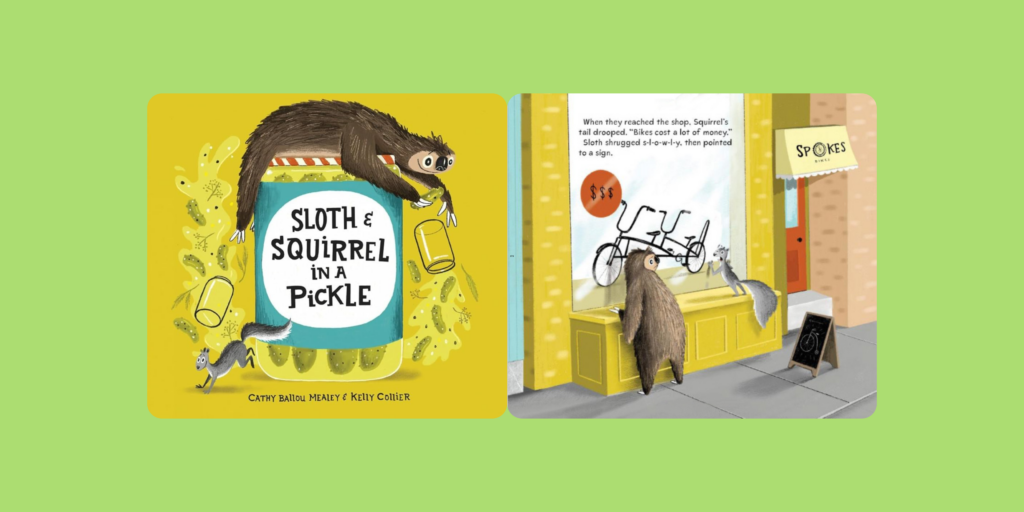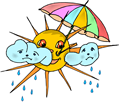
Grades 3-5

Don't have an account yet? Sign up for free
Don't have an account yet? Sign up for free


Can you learn economics from the weather? Students will be able to integrate science, math, and economics through this engaging lesson. The forecast predicts some percentage chance of success.
Ask students:
 What type of weather do you prefer on a play day? Sunny, windy, rainy, snowy, or stormy? Today’s lesson shows how something like the weather can influence the choices we make. We live in a world of scarcity; therefore, we have to make choices. Economics teaches us to make “good” choices. So what we choose to wear to go out and play on a snowy day will likely be very different than what we wear on a sunny day.
What type of weather do you prefer on a play day? Sunny, windy, rainy, snowy, or stormy? Today’s lesson shows how something like the weather can influence the choices we make. We live in a world of scarcity; therefore, we have to make choices. Economics teaches us to make “good” choices. So what we choose to wear to go out and play on a snowy day will likely be very different than what we wear on a sunny day.
Share the following poem and document to help the students understand economic choices.
Ask students to describe their favorite weather day. [Answers will vary. Allow students to share. Create a graph of class findings.]
Ask students if their favorite weather day was right now, what kind of clothes or other items would they want to have. [Answers will vary. Example: The students might want sunglasses, sunscreen, shorts, flip-flops, stocking caps, boots or a hat.]
Tell students that today they are going to learn economics from the weather.
Introduce the concept of economic wants. Explain that economic wants are desires that can be satisfied by consuming a good (an object), a service (an action), or a leisure activity.
Let’s review goods and services. Goods are objects or things that we can use, enjoy, or consume to satisfy our wants. A few examples of goods include toys, books, clothes, food, and games. Services are actions that satisfy consumers’ wants. Someone cutting your hair, mowing your lawn, or cleaning your house would be examples of services.
Tell students to think about Suzy. Suzy loves sunny days. She wants to be dressed for the sunny day, so she will enjoy being outdoors. Would Suzy want a coat or jacket? [Answers may vary, but most will agree she would not.] What would be an economic want Suzy might have to feel comfortably dressed for the sunny day? [Answer may include: She might want a swimsuit, shorts and t-shirt, or a lightweight dress. She might like to wear flip-flops or sandals, so her feet won’t be hot.]
If Suzy is thirsty, what economic want might satisfy her thirst? [Answers may include: Suzy might like a bottle of cold water, a glass of lemonade or iced tea, or a cold soft drink.]
Tell students to imagine now that Suzy has an economic want to play outside on the sunny day. Would she want a pair of snow skis? [Answers may vary, but most will say no.] Think of some goods that might satisfy Suzy’s economic wants. What might satisfy Suzy’s economic want for something to play with outside? [Answers may include: Suzy might want a jump rope, a beach ball, a bat and ball, or another good that would satisfy that want.]
Let’s pretend that Suzy and her family are at the beach. What services might Suzy’s family want to help them enjoy their stay at the beach? [An example of an acceptable answer: Suzy’s family might want to enjoy the services of the hotel they’re staying at while at the beach. Her family might rent a boat to go on a deep-sea fishing excursion. They might want to go to a water park.]
Now, let’s meet Sam. Sam loves winter weather. He loves a day when it is cold and snowy.
What is an economic want that Sam might have to satisfy his desire to stay warm while playing outside? [Examples might include: Sam would want a coat or jacket, gloves, scarf, sweater, or boots.]
Do you think Sam would want a swimsuit to stay warm while out playing in the snow? Why or why not?
[No, Sam would not want a swimuit to play in the snow. It wouldn’t satisfy his desire to stay warm while playing outside.]
What are some goods that might satisfy Sam’s want for something to eat or drink on a cold, wintry day? [Examples might include: Sam might want a cup of hot cocoa, a bowl of soup, or a cup of hot cider.]
Let’s think about Sam’s family. What are some services that Sam’s family might want if it were snowing that would satisfy their want to be safe and warm during the snowy weather? [An example of an acceptable response: Sam’s family might want someone to shovel the snow out of the driveway, so they may safely travel. If they were at a ski resort, they might hire an instructor to give them skiing lessons. If the heat weren’t working in their house, they would want a heating repair service to come fix the furnace.]
If Randy’s favorite type of weather was a rainy day, what economic wants might be on Randy’s list? [Examples might include: Randy would like to have an umbrella, a raincoat, or rain boots.]
Tell students it is important to remember that people have different economic wants. Sometimes it is just a personal choice. Sometimes it is because of the weather. The economic wants are not right or wrong. It is a decision each person makes after he or she thinks about the good and bad points of each good or service.
Click on the link to meet Sid, the Science Kid at https://pbskids.org/sid/games/weather-surprise . You will be challenged to determine if Sid’s economic wants are based on the weather. Click on the weather wheel, and then select the goods Sid would want for that weather day. When you have chosen the goods, click on the check mark to see how satisfied Sid is with your suggestions.
Remind students that today they learned economics from the weather.
What is an economic want? [An economic want is a desire that can be satisfied by consuming a good, service, or a leisure activity.]
Do we have the same economic wants every day? [No, we have different economic wants based on the weather and activities for the day.]
If Rosa goes out on a rainy day, what are two economic wants that Rosa might have to stay dry in the rain? [Rosa might like rain boots, a rain-coat, or an umbrella.]
If Stan goes out on a sunny day, what are three economic wants that might satisfy Stan’s thirst? [Answers may include drinks such as lemonade, ice water, Kool-Aid, punch, iced tea, or a soft drink.]
 If it is snowing, would you want a pair of flip-flops or snow boots to keep your feet warm? Why? [If it were snowing, you would want a pair of snow boots to keep your feet warm.]
If it is snowing, would you want a pair of flip-flops or snow boots to keep your feet warm? Why? [If it were snowing, you would want a pair of snow boots to keep your feet warm.]
If Anita’s family is on vacation in a snowy location, what services might Anita’s family want? [They may enjoy the services of the hotel where they are staying, they may wish to attend ski classes, they might want to visit an ice skating rink, or they may want a guide to help them find the best places for sledding.]
Science and Math Connections:
www.k-3learningpages.net/web%20weather.htm – This is a comprehensive site focusing on weather with many links to consider in an integrated unit.
www.weatherwizkids.com This link is designed by meteorologist, Crystal Wicker for students, parents, and teachers.
Literature Links:
The Kids’ Book of Weather Forecasting by Mark Breen. Ideals, 2008.
Oh Say Can You Say What’s the Weather Today? by Tish Gabe. Random House, 2004.
The Magic School Bus Kicks Up a Storm: A Book About Weather by Nancy White, Scholastic, 2000.
Weather Words and What They Mean by Gail Gibbons. Holiday House, 1992.
What Will the Weather Be? by Lynda DeWitt. Collins, 1993.

Grades 3-5

Grades 3-5, 6-8

Grades K-2, 3-5

Grades K-2
